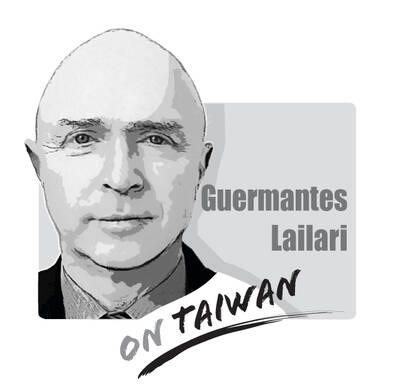The US House of Representatives on Friday last week passed the Department of Defense Appropriations Act for Fiscal 2026, which includes US$500 million in aid for Taiwan.
The bill passed with overwhelming support, though one vocal opponent of the Taiwan provision was Republican US Representative Marjorie Taylor Greene. She argued that increasing foreign aid to Taiwan would deepen its reliance on the US — an unsustainable burden given the US$37 trillion national debt.
Republican US Representative Ken Calvert disagreed, noting that US President Donald Trump’s administration had just issued a policy statement the day before calling for even more aid for Taiwan, recommending US$1 billion.
Supporting Taiwan aligns with core US interests, Calvert said, adding that the funding would “go a long way to make sure that Taiwan has the resources necessary to help prevent a Chinese invasion.”
Democratic US Representative Betty McCollum echoed that sentiment, stating that “Taiwan is threatened by the People’s Republic of China” and warning that other nations, including the Philippines, could also be at risk “if Taiwan falls.”
The aid is deeply appreciated by Taiwan and would meaningfully enhance its defense preparedness. However, Greene’s concerns are not without merit.
Ukraine, for example, has received significant foreign aid, but has also made substantial progress in building defense self-sufficiency. One notable area of success is on the battlefield, where Ukraine has innovated by repurposing captured Russian weapons, modifying existing drones and developing new ones.
Taiwan, too, has invested heavily in building up its domestic defense capabilities — particularly missiles, submarines and naval corvettes.
Most recently, Taiwan test-fired its extended-range Hsiung Feng III missiles for the first time during the annual Han Kuang exercises. The Hai Kun (海鯤) — Taiwan’s first domestically developed defense submarine — began its sea acceptance trials last month. And in March, the Endeavor Manta, Taiwan’s first military-specification uncrewed surface vehicle (USV), was unveiled at Kaohsiung’s Singda Harbor.
Taiwan should engage Washington in discussions about channeling portions of US aid toward the development of its domestic defense industry. Doing so could mitigate delays in shipments of US-made systems by enabling Taiwan to develop alternatives at home. In the long term, this could position Taiwan as a defense supplier to regional allies such as the Philippines.
A Washington Post report on Monday last week said that the Philippines is seeking closer defense collaboration with Taiwan amid escalating Chinese threats. The two sides have conducted joint patrols of the Bashi Channel and Taiwan sent observers to a US-Philippines-Japan military exercise in the Batanes Islands. Taiwan could provide the Philippines with USVs, corvettes and submarines to help patrol the strategically vital Bashi Channel.
Such developments would not replace Taiwan’s procurement of US arms, but would complement them. In this year’s Han Kuang exercises, Taiwan tested a range of US-supplied systems, including M1A2T main battle tanks, High Mobility Artillery Rocket Systems, TOW-2B anti-tank missiles, land-based Harpoon anti-ship missiles and various uncrewed aerial vehicles. Taiwan is also expecting delivery of Lockheed Martin F-16C/D Block 70/72 jets.
The US remains an indispensable defense partner, offering essential training, support and advanced weapons systems, but as Greene pointed out, Taiwan cannot depend indefinitely on US funding for its defense — nor should it need to. With continued support from the US, Taiwan must persist in developing its domestic defense industry, bolstering self-reliance, while contributing proactively to regional peace and security.

Chinese state-owned companies COSCO Shipping Corporation and China Merchants have a 30 percent stake in Kaohsiung Port’s Kao Ming Container Terminal (Terminal No. 6) and COSCO leases Berths 65 and 66. It is extremely dangerous to allow Chinese companies or state-owned companies to operate critical infrastructure. Deterrence theorists are familiar with the concepts of deterrence “by punishment” and “by denial.” Deterrence by punishment threatens an aggressor with prohibitive costs (like retaliation or sanctions) that outweigh the benefits of their action, while deterrence by denial aims to make an attack so difficult that it becomes pointless. Elbridge Colby, currently serving as the Under
The Ministry of the Interior on Thursday last week said it ordered Internet service providers to block access to Chinese social media platform Xiaohongshu (小紅書, also known as RedNote in English) for a year, citing security risks and more than 1,700 alleged fraud cases on the platform since last year. The order took effect immediately, abruptly affecting more than 3 million users in Taiwan, and sparked discussions among politicians, online influencers and the public. The platform is often described as China’s version of Instagram or Pinterest, combining visual social media with e-commerce, and its users are predominantly young urban women,
Most Hong Kongers ignored the elections for its Legislative Council (LegCo) in 2021 and did so once again on Sunday. Unlike in 2021, moderate democrats who pledged their allegiance to Beijing were absent from the ballots this year. The electoral system overhaul is apparent revenge by Beijing for the democracy movement. On Sunday, the Hong Kong “patriots-only” election of the LegCo had a record-low turnout in the five geographical constituencies, with only 1.3 million people casting their ballots on the only seats that most Hong Kongers are eligible to vote for. Blank and invalid votes were up 50 percent from the previous
Japanese Prime Minister Sanae Takaichi lit a fuse the moment she declared that trouble for Taiwan means trouble for Japan. Beijing roared, Tokyo braced and like a plot twist nobody expected that early in the story, US President Donald Trump suddenly picked up the phone to talk to her. For a man who normally prefers to keep Asia guessing, the move itself was striking. What followed was even more intriguing. No one outside the room knows the exact phrasing, the tone or the diplomatic eyebrow raises exchanged, but the broad takeaway circulating among people familiar with the call was this: Trump did